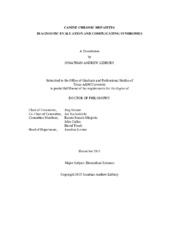| dc.description.abstract | Chronic hepatitis is an important disease in dogs that can lead to hepatic fibrosis, portal hypertension, and hepatic encephalopathy. Histological assessment of liver biopsy specimens is currently required to definitively diagnose chronic hepatitis and hepatic fibrosis. To evaluate inter-observer agreement arising from the assessment of canine hepatic fibrosis and necroinflammatory activity, six pathologists assigned scores to histological sections of canine livers. To assess the diagnostic utility of extracellular components as serum markers of hepatic fibrosis, dogs with hepatobiliary disease and healthy dogs were enrolled. For the dogs with hepatobiliary disease hepatic fibrosis was histologically scored. To assess the utility of urine N-methylhistamine as a marker of mast cell mediated inflammation, urine N-methylhistamine to creatinine ratios were measured in dogs with hepatobiliary disease and healthy control dogs. Urine Nmethylhistamine to creatinine ratios were compared to hepatic mast cell counts in dogs with hepatobiliary disease. To elucidate the relationship between plasma ammonia concentration and severity of hepatic encephalopathy, and to determine whether factors that precipitate hepatic encephalopathy in humans are associated with the presence of hepatic encephalopathy in dogs previously treated for the disease, the medical records of dogs diagnosed with hepatic encephalopathy were retrospectively reviewed.
There was fair and poor agreement between pathologists assessing hepatic fibrosis and necroinflammation, respectively. This suboptimal agreement needs to be taken into account by clinicians making decisions based on hepatic histopathology reports. Despite their diagnostic utility for diagnosing hepatic fibrosis in humans the results of this work do not support the utility of the extracellular matrix components studied here to discriminate between dogs with and without hepatic fibrosis. A subset of dogs with hepatobiliary disease had mildly increased urine N-methylhistamine to creatinine ratios, suggesting mast cell mediated inflammation. However, there was no correlation between urine N-methylhistamine to creatinine ratio and hepatic mast cell counts. Severity of hepatic encephalopathy was not significantly correlated with plasma ammonia concentrations and none of the putative precipitating factors for hepatic encephalopathy were associated with the presence of clinical signs of the disease at hospital admission. Further work is needed to better define the pathogenesis of canine hepatic encephalopathy. | en |


